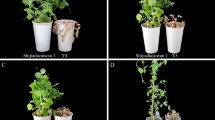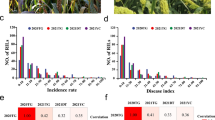Abstract
Vertcillium wilt (VW, Verticillium dahliae Kleb.) is one of the most important soil-borne fungal diseases affecting world cotton production. Numerous studies have been conducted to investigate the genetic basis of VW resistance using bi-parental or association map** populations. In this study, a multi-parent advanced generation inter-cross (MAGIC) population of 550 recombinant inbred lines (RILs) together with their 11 Upland cotton parents with a total of 473,516 polymorphic SNP markers was used to identify chromosomal regions for VW resistance based on foliar disease severity ratings (DSR) in two replicated greenhouse tests. Among the 11 parents, Acala Ultima, Coker 315, and Deltapine Acala 90 in the two tests and FiberMax 966 in one test and on average were significantly more resistant than the susceptible check parent- Phytogen PSC 355, while Paymaster HS 26, SureGrow 747, Stoneville 474, Stoneville 825, and Tamcot Pyramid performed similarly to PSC 355. Although a significant genotype × test interaction was detected for DSR, 37 MAGIC lines were consistently resistant to VW. Of 13 and 12 VW resistance QTL declared in Test 1 and 2, respectively, through a genome-wide association study (GWAS), three QTL on chromosome A01, D02 and D08 were in common and three QTL clusters were detected on chromosome A01, A13, and D01 between the two tests. The narrow chromosomal regions for the three common resistance QTL allowed identification of possible candidate genes for VW resistance. This greenhouse study identified VW resistant parents and RILs and common resistance QTL for VW resistance, providing useful information for develo** VW resistant cultivars and further genomic studies towards the identification of VW resistance genes in cotton.


Similar content being viewed by others
References
Abdelraheem A, Liu F, Song M, Zhang JF (2017) A meta-analysis of quantitative trait loci for abiotic and biotic stress resistance in tetraploid cotton. Mol Genet Genom 292:1221–1235
Abdelraheem A, Elassbli H, Zhu Y, Kuraparthy V, Hinze L, Stelly D, Wedegaertner T, Zhang JF (2019) A genome-wide association study uncovers consistent quantitative trait loci for resistance to Verticillium wilt and Fusarium wilt in the U.S. Upland cotton. Theor Appl Genet. https://doi.org/10.1007/s00122-019-03487-x
Baytar AA, Erdogan O, Frary A, Frary A, Doganlar S (2017) Molecular diversity and identification of alleles for Verticillium wilt resistance in elite cotton (Gossypium hirsutum L.) germplasm. Euphytica 213:31
Blasingame D, Patel MV (2013) Cotton disease loss estimate committee report. In: Proceedings of the beltwide cotton conferences, San Antonio, pp 1242–1245
Daayf F, Nicole M, Geiger JP (1995) Differentiation of Verticillium dahliae populations on the basis of vegetative compatibility and pathogenicity on cotton. Eur J Plant Pathol 101:69–79
Fang H, Zhou H, Sanogo S, Flynn R, Percy RG, Hughs SE et al (2013) Quantitative trait locus map** for Verticillium wilt resistance in a backcross inbred line population of cotton (Gossypium hirsutum × Gossypium barbadense). Euphytica 194:79–91
Fang H, Zhou H, Sanogo S, Lipka AE, Fang DD, Percy RG et al (2014) Quantitative trait locus analysis of Verticillium wilt resistance in an introgressed recombinant inbred line population of Upland cotton. Mol Breed 33:709–720
Guo XH, Cai CP, Yuan DD, Zhang RS, ** JL, Guo WZ (2016) Development and identification of Verticillium wilt-resistant upland cotton accessions by pyramiding QTL related to resistance. J Integr Agric 15:512–520
Hu XP, Gurung S, Short DPG, Sandoya GV, Shang WJ, Hayes RJ, Davis RM, Subbarao KV (2015) Nondefoliating and defoliating strains from cotton correlate with races 1 and 2 of Verticillium dahliae. Plant Dis 99:1713–1720
Hu Y, Chen J, Fang L, Zhang Z, Ma W, Niu Y, Ju L, Deng J, Zhao T, Lian J, Baruch K, Fang D, Liu X, Ruan YL, Rahman MU, Han J, Wang K, Wang Q, Wu H, Mei G, Zang Y, Han Z, Xu C, Shen W, Yang D, Si Z, Dai F, Zou L, Huang F, Bai Y, Zhang Y, Brodt A, Ben-Hamo H, Zhu X, Zhou B, Guan X, Zhu S, Chen X, Zhang T (2019) Gossypium barbadense and Gossypium hirsutum genomes provide insights into the origin and evolution of allotetraploid cotton. Nat Genet 51:739–748
Islam MS, Thyssen GN, Jenkins JN, Zeng L, Delhom CD, McCarty JC, Deng DD, Hinchliffe DJ, Jones DC, Fang DD (2016) A MAGIC population-based genome-wide association study reveals functional association of GhRBB1_A07 gene with superior fiber quality in cotton. BMC Genom 17:903
Jenkins JN, McCarty JC, Gutierrez OA, Hayes RW, Bowman DT, Watson CE, Jones DC (2008) Registration of RMUP-C5, a random mated population of Upland cotton germplasm. J Plant Regist 2:239–244
Karademir E, Karademir C, Ekinci R, Baran B, Sagir A (2012) Effect of Verticillium dahliae Kleb. on cotton yield and fiber technological properties. Int J Plant Prod 6:387–407
Li T, Ma X, Li N, Zhou L, Liu Z, Han H, Gui Y, Bao Y, Chen J, Dai X (2017) Genome-wide association study discovered candidate genes of Verticillium wilt resistance in upland cotton (Gossypium hirsutum L.). Plant Biotechnol J 15:1520–1532
Li H, Handsaker B, Wysoker A, Fennell T, Ruan J, Homer N, Marth G, Abecasis G, Durbin R, Genome Project Data Processing S (2009) The sequence alignment/map format and SAMtools. Bioinformatics 25:2078–2079
Lipka AE, Tian F, Wang Q, Peiffer J, Li M, Bradbury PJ, Gore MA, Buckler ES, Zhang Z (2012) GAPIT: genome association and prediction integrated tool. Bioinformatics 28:2397–2399
Naoumkina M, Thyssen GN, Fang DD, Jenkins JN, McCarty JC, Florane CB (2019) Genetic and transcriptomic dissection of the fiber length trait from a cotton (Gossypium hirsutum L.) MAGIC population. BMC Genom 20:112
Ning Z, Zhao R, Chen H, Ai N, Zhang X, Zhao J, Mei H, Wang P, Guo W, Zhang T (2013) Molecular tagging of a major quantitative trait locus for broad-spectrum resistance to Verticillium wilt in upland cotton cultivar Prema. Crop Sci 53:2304–2312
Oakley S (1998) Breeding for resistance to Verticillium wilt and root-knot nematode in California Acalas. In: Proceedings Beltwide Cotton Conferences, p 128
Palanga KK, Jamshed M, Rashid MHO, Gong J, Li J, Iqbal MS, Liu A, Shang H, Shi Y, Chen T, Ge Q, Zhang Z, Dilnur T, Li W, Li P, Gong W, Yuan Y (2017) Quantitative trait locus map** for Verticillium wilt resistance in an upland cotton recombinant inbred line using SNP-based high density genetic map. Front Plant Sci 8:382
Schnathorst WC, Mathre DE (1966) Host range and differentiation of a severe form of Verticillium albo-atrum in cotton. Plant Dis 56:1156–1161
Shaban M, Miao Y, Ullah A, Khan AQ, Menghwar H, Khan AH, Ahmed MM, Tabassum MA, Zhu L (2018) Physiological and molecular mechanism of defense in cotton against Verticillium dahliae. Plant Physiol Biochem 125:193–204
Shi Y, Zhang B, Liu A, Li W, Li J, Lu Q, Zhang Z, Li S, Gong W, Shang H, Gong J, Chen T, Ge Q, Wang T, Zhu H, Liu Z, Yuan Y (2016) Quantitative trait loci analysis of Verticillium wilt resistance in interspecific backcross populations of Gossypium hirsutum × Gossypium barbadense. BMC Genom 17:877
Smith CW, Cantrell RG, Moser HS, Oakley SR (1999) Historyof cultivar development in the United States. In: Smith CW, Cothren JT (eds) Cotton: origin history technology, and production. Wiley, New York, pp 99–171
Sun H, Meng M, Yan Z, Lin Z, Nie N, Yang X (2019) Genome-wide association of stress tolerance traits in cotton. Crop J 7:77–88
Takagi H, Abe A, Yoshida K, Kosugi S, Natsume S, Mitsuoka C, Uemura A, Utsushi H, Tamiru M, Takuno S, Innan H, Cano LM, Kamoun S, Terauchi R (2013) QTL-seq: rapid map** of quantitative trait loci in rice by whole genome resequencing of DNA from two bulked populations. Plant J 74:174–183
Thyssen GN, Jenkins JN, McCarty JC, Zeng L, Campbell BT, Delhom CD, Islam MS, Li P, Jones DC, Condon BD, Fang DD (2019) Whole genome sequencing of a MAGIC population identified genomic loci and candidate genes for major fiber quality traits in upland cotton (Gossypium hirsutum L.). Theor Appl Genet 132:989–999
Wang M, Tu L, Yuan D, Zhu L, Shen C, Li J, Liu F, Pei L, Wang P, Zhao G, Ye Z, Huang H, Yan F, Ma Y, Zhang L, Liu M, You J, Yang Y, Liu Z, Huang F, Li B, Qiu P, Zhang Q, Zhu L, ** S, Yang X, Min L, Li G, Chen LL, Zheng H, Lindsey K, Lin Z, Udall JA, Zhang X (2019) Reference genome sequences of two cultivated allotetraploid cottons, Gossypium hirsutum and Gossypium barbadense. Nat Genet 51:224–229
Wheeler TA, Schuster GL (2006) Cultivar susceptibility to Verticillium wilt on the High Plains of Texas. In: Proceedings Beltwide Cotton Conference San Antonio, National Cotton Council, Memphis, p 85–92
Wheeler TA, Woodward JE (2016) Field assessment of commercial cotton cultivars for Verticillium wilt resistance and yield. Crop Prot 88:1–6
Wilhelm S, Sagen JE, Tietz H (1974) Resistance to Verticillium wilt in cotton: sources, techniques of identification, inheritance trends, and the resistance potential of multiline cultivars. Phytopathology 64:924–931
Wu TD, Nacu S (2010) Fast and SNP-tolerant detection of complex variants and splicing in short reads. Bioinformatics 26:873–881
Zhang Z, Ersoz E, Lai C-Q, Todhunter RJ, Tiwari HK, Gore MA, Bradbury PJ, Yu J, Arnett DK, Ordovas JM et al (2010) Mixed linear model approach adapted for genome-wide association studies. Nat Genet 42:355
Zhang JF, Sanogo S, Flynn R, Baral JB, Bajaj S, Hughs SE et al (2012) Germplasm evaluation and transfer of Verticillium wilt resistance from Pima (Gossypium barbadense) to Upland cotton (G. hirsutum). Euphytica 187:147–160
Zhang JF, Fang H, Zhou HP, Sanogo S, Ma ZY (2014a) Genetics, breeding, and marker-assisted selection for Verticillium wilt resistance in cotton. Crop Sci 54:1289–1303
Zhang JF, Percy RG, McCarty JC Jr (2014b) Introgression genetics and breeding between Upland and Pima cotton- a review. Euphytica 198:1–12
Zhang X, Yuan Y, Wei Z, Guo X, Guo Y, Zhang S, Zhao J, Zhang G, Song X, Sun X (2014c) Molecular map** and validation of a major QTL conferring resistance to a defoliating isolate of Verticillium wilt in cotton (Gossypium hirsutum L.). PLoS ONE 9:e96226
Zhang J, Yu J, Pei W, Li X, Said J, Song M, Sanogo S (2015a) Genetic analysis of Verticillium wilt resistance in a backcross inbred line population and a meta-analysis of quantitative trait loci for disease resistance in cotton. BMC Genom 16:577
Zhang T, Hu Y, Jiang W, Fang L, Guan X, Chen J, Zhang J, Saski CA, Scheffler BE, Stelly DM et al (2015b) Sequencing of allotetraploid cotton (Gossypium hirsutum L. acc. TM-1) provides a resource for fiber improvement. Nat Biotechnol 33:531–537
Zhang Y, Wang L, Li Z, Zhang G, Wang X, Ma Z (2016) Targeted transfer of trait for Verticillium wilt resistance from Gossypium barbadense into G. hirsutum using SSR markers. Plant Breed 135:476–482
Zhao Y, Wang H, Chen W, Li Y (2014) Genetic structure, linkage disequilibrium and association map** of Verticillium wilt resistance in elite cotton (Gossypium hirsutum L.) germplasm population. PLoS ONE 9:e86308
Zhao Y, Wang H, Chen W, Zhao P, Gong H, Sang X, Cui Y (2017) Regional association analysis-based fine map** of three clustered QTL for Verticillium wilt resistance in cotton (G. hirsutum L). BMC Genomics 18:661
Zhao J, Liu J, Xu J, Zhao L, Wu Q, ** and candidate gene analysis for Verticillium wilt resistance using Gossypium barbadense chromosomal segment introgressed line. Front Plant Sci 9:682
Zhou HP, Fang H, Sanogo S, Hughs SE, Jones DC, Zhang JF (2014) Evaluation of Verticillium wilt resistance in commercial cultivars and advanced breeding lines of cotton. Euphytica 196:437–448
Author information
Authors and Affiliations
Corresponding author
Additional information
Publisher's Note
Springer Nature remains neutral with regard to jurisdictional claims in published maps and institutional affiliations.
Rights and permissions
About this article
Cite this article
Zhang, J., Abdelraheem, A., Thyssen, G.N. et al. Evaluation and genome-wide association study of Verticillium wilt resistance in a MAGIC population derived from intermating of eleven Upland cotton (Gossypium hirsutum) parents. Euphytica 216, 9 (2020). https://doi.org/10.1007/s10681-019-2547-6
Received:
Accepted:
Published:
DOI: https://doi.org/10.1007/s10681-019-2547-6




